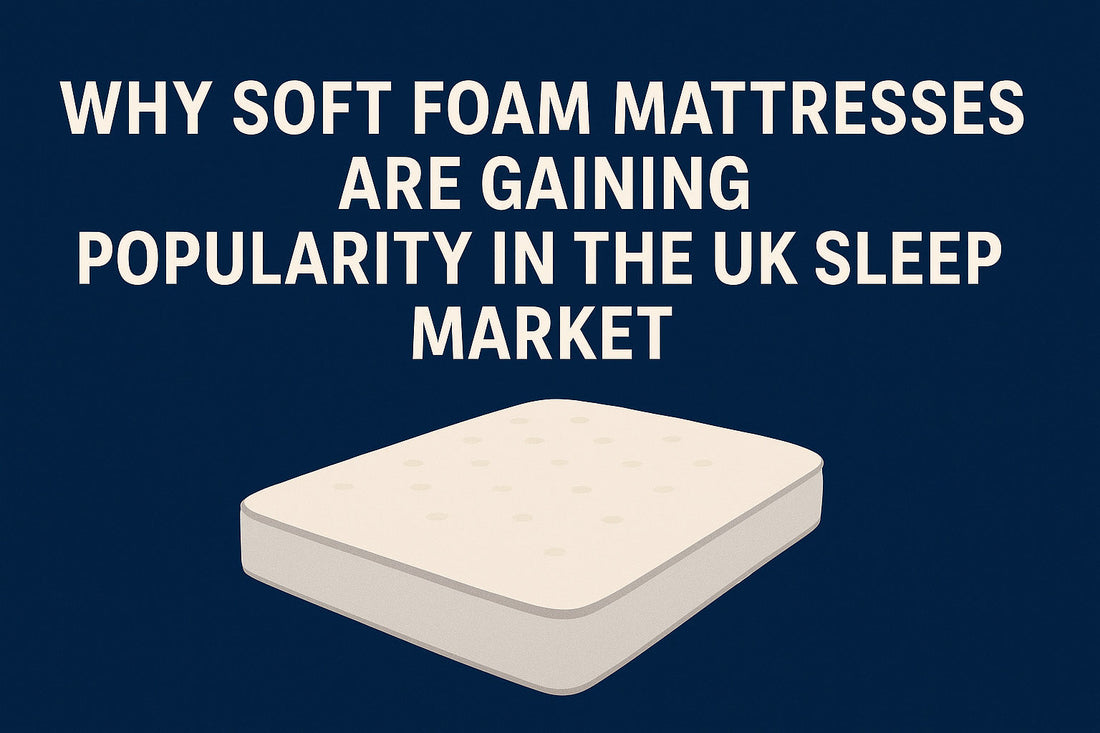In recent years, the UK sleep industry has witnessed a marked shift in consumer preference: a growing demand for soft foam mattresses. Once seen as a niche product or suitable only for lightweight sleepers, soft foam mattresses are now at the forefront of modern sleep solutions, appealing to a broad demographic. From ergonomic support to luxury comfort, this shift reflects both lifestyle changes and advancements in sleep science. But what exactly is driving the popularity of soft foam mattresses in the UK market?
This comprehensive guide dives into the reasons behind the surge in popularity and examines why more UK consumers are turning to soft foam as their sleep material of choice.
1. Understanding Soft Foam Technology
Soft foam mattresses primarily consist of memory foam, polyurethane foam, or a blend of multiple foam types that create a plush, body-conforming feel. Originally developed by NASA to cushion astronauts during space travel, memory foam found its way into consumer products because of its excellent pressure-relief capabilities.
Soft foam mattresses are typically engineered with several layers:
-
Top comfort layer: Offers plushness and contours to the sleeper’s body.
-
Transition layer: A slightly firmer layer that supports pressure points.
-
Base layer: Dense foam for stability and longevity.
The ability of these layers to absorb motion, relieve pressure, and adapt to body heat has made soft foam particularly attractive to today’s comfort-conscious consumers.
For those new to memory foam, Sleep Foundation provides a detailed breakdown of how this technology works.
2. Comfort That Adapts to the Body
One of the main draws of soft foam is its contouring ability. Unlike traditional spring mattresses that push back against the body, soft foam molds to your shape. This helps distribute body weight more evenly and reduces pressure on common pain points such as the hips, shoulders, and lower back.
This contouring support is especially valuable for side sleepers and individuals with chronic pain. A 2022 UK sleep health study published by the National Institute for Health and Care Excellence (NICE) found that pressure-relieving sleep surfaces significantly improve sleep quality for individuals with musculoskeletal issues.
3. Improved Motion Isolation for Couples
Another major benefit of soft foam mattresses is their ability to absorb motion. When one person moves or gets out of bed, the motion does not ripple across the surface — a common complaint with innerspring mattresses.
For couples, this feature translates to uninterrupted sleep and less nighttime disturbance. Soft foam’s motion isolation is one reason it’s often ranked among the top choices in Which? mattress reviews, the UK’s leading product testing platform.
4. Better Sleep in Colder Climates
The UK climate tends to lean on the cooler side for much of the year. This makes soft foam’s heat-retention property more of a benefit than a drawback. Soft foam mattresses retain body heat, offering a warm and cozy sleep environment during colder months.
Newer generations of foam incorporate gel-infused technology and open-cell structures to address overheating concerns. Brands like Tempur and Emma have introduced these innovations to balance temperature regulation while maintaining comfort.
If you’re concerned about temperature control, The Sleep Council UK offers helpful tips on choosing the right sleep environment for seasonal changes.
5. Minimal Maintenance and Long Lifespan
Unlike traditional coil mattresses that need to be flipped regularly, soft foam mattresses require less upkeep. Most only need to be rotated occasionally to maintain even wear. Their dense structure also resists sagging for longer, often maintaining their shape for 7–10 years or more with proper care.
This durability is enhanced by the use of high-resilience (HR) foam layers in many premium UK-made soft foam mattresses.
6. Affordability and Availability
With the rise of direct-to-consumer mattress brands, soft foam mattresses have become more accessible and affordable. UK companies like Simba, OTTY, and Eve Sleep have led this charge, offering competitive pricing and generous trial periods.
Most soft foam mattresses are now shipped in a box, compressed for easy transport. This convenience makes them ideal for renters, students, and urban dwellers who may face logistical issues with traditional mattress delivery.
You can explore soft foam mattress options and comparisons on platforms like Mattress Online and SleepHero.
7. Alignment with Wellness Trends
Wellness has become a central theme in British consumer behaviour, and mattress brands are responding. Today’s buyers are not only focused on comfort but also on how sleep contributes to mental health, fitness recovery, and productivity.
Soft foam mattresses are often marketed as therapeutic tools that aid relaxation and stress relief. This aligns with modern mindfulness practices and the pursuit of “clean sleeping,” a term popularised by health advocates such as Gwyneth Paltrow.
You can learn more about the link between sleep and wellness from The Sleep Charity, a UK-based nonprofit promoting better sleep health.
8. Personalisation and Sleep Trials
UK consumers today expect personalisation in almost every aspect of their lives — and mattresses are no exception. Soft foam options now come in a variety of firmness levels, heights, and even targeted support zones to meet individual needs.
Many brands now offer 100-night (or more) risk-free trials, where you can sleep on a mattress at home and return it if it doesn’t meet your expectations. This has removed much of the hesitation that once accompanied foam mattresses.
Companies like LuxeMattresses.co.uk are leading this movement by combining affordable pricing with custom options, extensive warranties, and generous return policies.
9. Sustainability and Eco-Friendly Options
Consumers are becoming more eco-conscious, and mattress brands are taking notice. Many soft foam mattresses now incorporate sustainable materials like natural latex, recycled fabrics, or plant-based memory foam alternatives.
Certifications such as CertiPUR-US and OEKO-TEX ensure that the foam used is low in harmful emissions and safe for indoor air quality. This is particularly important in small or poorly ventilated UK homes.
For a deeper look at sustainability certifications, visit Good Housekeeping UK.
10. Changing Buyer Demographics
Finally, the shift in demographics also plays a role in the rising popularity of soft foam mattresses. Younger consumers — particularly Millennials and Gen Z — are more likely to shop online, read reviews, and prioritise comfort, convenience, and value.
Soft foam mattresses cater directly to these expectations. With digital-first companies offering sleek packaging, Instagram-friendly branding, and hassle-free returns, soft foam mattresses are the sleep surface of choice for the modern UK buyer.
Conclusion
The rise of soft foam mattresses in the UK is no accident — it’s the result of evolving sleep science, shifting lifestyle habits, and innovative consumer-first design. With a combination of plush comfort, practical features, and long-term health benefits, it’s easy to see why so many Britons are switching to soft foam for a better night’s rest.
Whether you’re struggling with back pain, sharing a bed with a partner, or simply looking for a more luxurious sleep experience, a soft foam mattress might be the upgrade your sleep has been waiting for.

